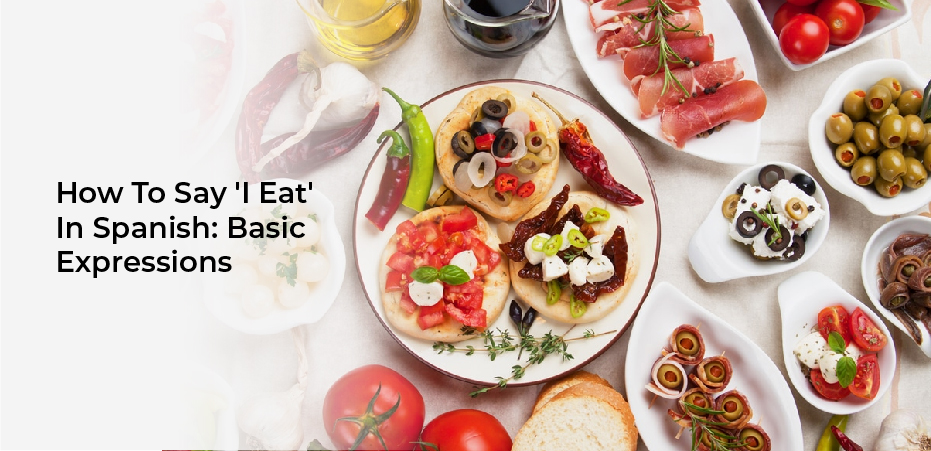Are you planning to travel to a Spanish-speaking country and want to be able to communicate about eating? Knowing how to say ‘I eat’in Spanish is a great first step!
In this article, we will cover basic expressions for talking about eating in Spanish, as well as vocabulary for food and meals. Conjugating verbs for ‘I eat’in Spanish can be tricky, but we will break it down for you and provide different ways to express eating in Spanish.
We will also provide a fun role-play activity to help you practice using these expressions in everyday conversations. By the end of this article, you’ll be able to confidently talk about eating in Spanish and impress your Spanish-speaking friends and colleagues.
Vamos a comer! (Let’s eat!)
Expressions for Talking about Eating in Spanish
Don’t know how to talk about your love for food in Spanish? Check out these expressions for talking about eating and get ready to indulge in some delicious conversations!
When you want to say ‘I eat’ in Spanish, you can use the phrase ‘yo como.’ This simple expression is used to talk about the act of eating, regardless of what you’re eating or where you’re eating it.
If you want to be more specific, you can use other expressions like ‘yo desayuno’ (I have breakfast), ‘yo almuerzo’ (I have lunch), or ‘yo ceno’ (I have dinner). These expressions are great for talking about your daily eating habits and routines.
In addition, you can use expressions like ‘me gusta comer’ (I like to eat) or ‘amo la comida’ (I love food) to express your passion for all things culinary. With these expressions, you’ll be able to talk about your love for food and eating in Spanish with ease.
Basic Vocabulary for Food and Meals in Spanish
You’ll quickly pick up common food and meal terms in no time en español. Knowing the basic vocabulary for food and meals in Spanish is essential if you want to communicate effectively with native speakers. Here are some of the most common words you need to know:
Firstly, you should learn the names of different food items. For instance, arroz (rice), carne (meat), pescado (fish), and frutas (fruits) are some of the most frequently used words in Spanish when referring to food. You should also learn how to order meals and drinks in restaurants. For example, you could say “Quiero un café con leche, por favor”(I want a latte, please) or “Me gustaría un plato de paella”(I would like a plate of paella). Remember, it’s all about practice! The more you use these words and phrases, the more comfortable you’ll feel speaking Spanish.
Secondly, it’s important to know the names of meals and mealtimes. Desayuno (breakfast), almuerzo (lunch), and cena (dinner) are the three main mealtimes in Spanish-speaking countries. Additionally, you may hear the term merienda, which refers to a small snack usually eaten in the afternoon.
Knowing these basic words will help you navigate menus and communicate your meal preferences to others. So, if you’re learning Spanish, make sure to practice these words and phrases regularly. With a bit of effort, you’ll soon be able to talk about food and meals with ease!
Conjugating Verbs for ‘I Eat’ in Spanish
Feast on the flavors of Spanish culture by mastering the art of conjugating verbs for “I eat”in Spanish, and you’ll feel a sense of accomplishment and pride with every tasty bite.
The most common way to say “I eat”in Spanish is “yo como.”Remember that in Spanish, verbs change depending on the subject pronoun, so it’s important to learn the different conjugations.
For example, “tú comes”means “you eat,””él/ella come”means “he/she eats,”and “nosotros/nosotras comemos”means “we eat.”
To form the present tense of regular verbs, simply remove the infinitive ending (-ar, -er, or -ir) and add the appropriate ending.
For example, for the verb “comer,”which means “to eat,”you would remove the -er ending and add -o for “yo como,”-es for “tú comes,”-e for “él/ella come,”and -emos for “nosotros/nosotras comemos.”
With practice, you’ll become more comfortable with conjugating verbs and be able to express yourself in Spanish with ease.
Different Ways to Express Eating in Spanish
Indulge in the diverse culinary experiences of the Spanish-speaking world by exploring the various ways to express the act of consuming food in the language.
In addition to the basic expressions like ‘yo como’ (I eat), there are multiple other phrases that can be used to convey the same idea. For example, ‘yo me alimento’ (I nourish myself) or ‘yo ingiero alimentos’ (I ingest food) are both acceptable ways to express the act of eating in Spanish.
Furthermore, there are also regional differences in the way people talk about eating in Spanish. For instance, in some Spanish-speaking countries, people may say ‘yo desayuno’ (I breakfast) instead of ‘yo desayuno comida’ (I eat breakfast), or ‘yo almuerzo’ (I lunch) instead of ‘yo almuerzo comida’ (I eat lunch).
These differences reflect the unique cultural and linguistic nuances of different Spanish-speaking regions and can add an interesting layer of complexity to the language.
Role-Play: Using ‘I Eat’ Expressions in Everyday Conversations
Let’s spice up our everyday dialogues by incorporating various phrases to express the act of consuming food in Spanish. This will add depth to our language skills. For example, you could use ‘me alimento’ or ‘ingiero alimentos’.
Imagine you’re at a restaurant with a Spanish-speaking friend. You could say, “Me voy a pedir una ensalada”(I’m going to order a salad) or “Voy a comer un filete”(I’m going to eat a steak) to express your food choices.
In another scenario, if your co-worker asks what you’re doing during your break time, you could use the phrase “Estoy merendando”(I’m snacking). Or, when your grandmother asks if you’ve eaten yet, you could respond with “Sí, ya comí”(Yes, I already ate).
By incorporating different expressions to describe the act of eating, you can improve your communication skills and connect with Spanish speakers on a deeper level.
Frequently Asked Questions
What are some common Spanish dishes that use the verb “comer”(to eat)?
“You can try some delicious Spanish dishes like paella, tortilla española, or gazpacho, all of which use the verb ‘comer’ (to eat) in their preparation. Why not give them a try?” ‘You may discover a new favorite dish and expand your culinary horizons!’
Can you provide some tips for ordering food in a Spanish-speaking restaurant?
To order food at a Spanish-speaking restaurant, start by greeting your waiter with “Hola”and asking for the menu, “¿Puedo ver el menú, por favor?”You can then use phrases like “Quiero”(I want) or “Me gustaría”(I would like) to place your order. Don’t forget to say “Gracias”when your food arrives!
How do you say “hungry”or “full”in Spanish?
To say ‘hungry’ in Spanish, you can say ‘tienes hambre’. To say ‘full’, you can say ‘estás lleno’. These phrases can be useful when ordering food at a Spanish-speaking restaurant.
Are there any cultural customs or etiquette to keep in mind when dining in a Spanish-speaking country?
When dining in a Spanish-speaking country, it’s important to keep in mind certain customs and etiquette, such as waiting for everyone to be served before eating, using utensils properly, and not leaving food on your plate.
How does the use of “I eat”expressions differ in different Spanish-speaking countries or regions?
Different Spanish-speaking countries or regions may have variations in their use of ‘I eat’ expressions. It’s best to observe and adapt to local customs. Don’t be afraid to ask for clarification or assistance to avoid any misunderstandings.
Conclusion
So, there you have it! You’ve learned the basic expressions for talking about eating in Spanish, as well as the essential vocabulary for food and meals.
By conjugating verbs for ‘I eat’ in Spanish, you can now express that you eat something in the present tense.
Remember that there are different ways to express eating in Spanish, depending on the context and the type of food.
Don’t be afraid to practice using these expressions in your everyday conversations with Spanish speakers. The more you use them, the more natural they’ll become.
¡Buen provecho! (Enjoy your meal!)


